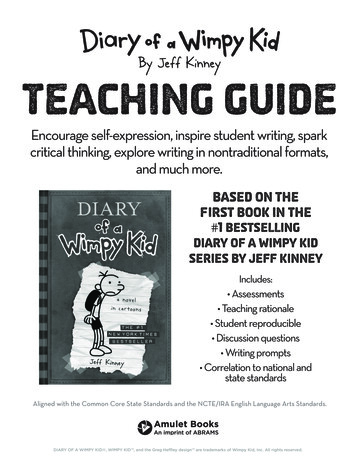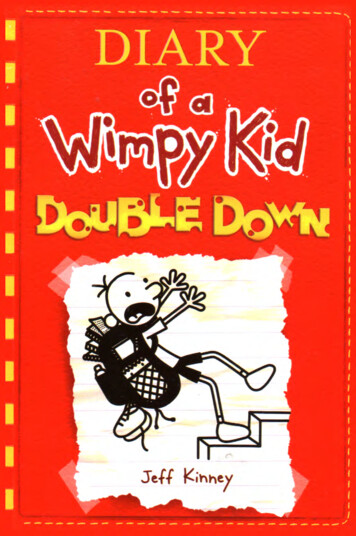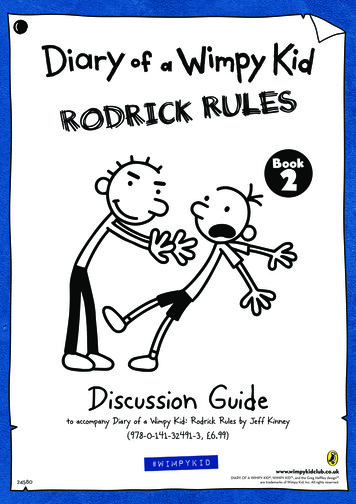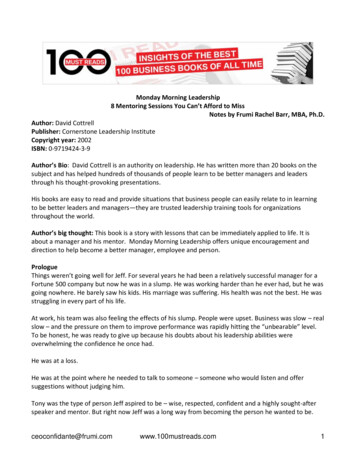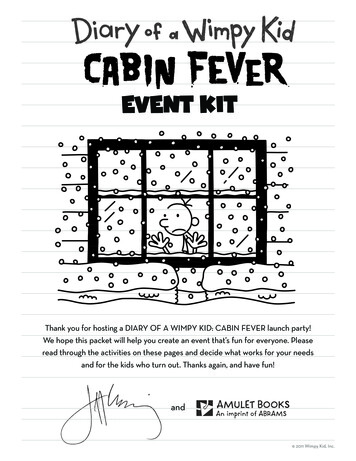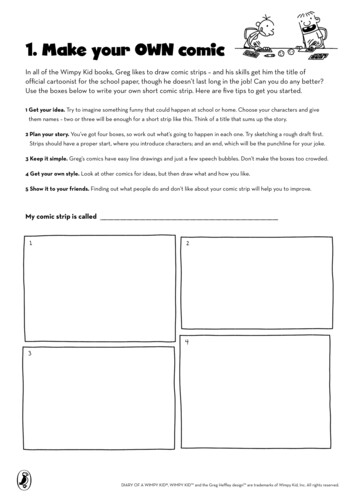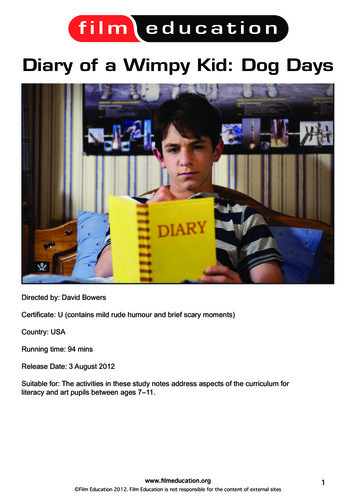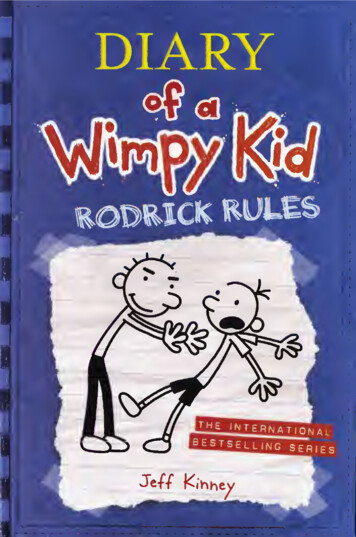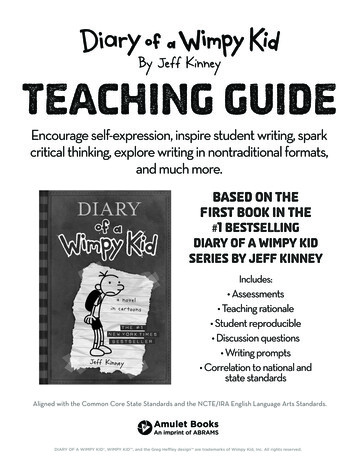
Transcription
By Jeff KinneyTeaching guideEncourage self-expression, inspire student writing, sparkcritical thinking, explore writing in nontraditional formats,and much more.based on thefirst book in the#1 bestsellingdiary of a wimpy kidseries by jeff kinneyIncludes: Assessments Teaching rationale Student reproducible Discussion questions Writing prompts Correlation to national andstate standardsAligned with the Common Core State Standards and the NCTE/IRA English Language Arts Standards.DIARY OF A WIMPY KID , WIMPY KID , and the Greg Heffley design are trademarks of Wimpy Kid, Inc. All rights reserved.1
About the BookThis book is a journal—NOT a diary—belongingto Greg Heffley, a middle school studentstruggling to navigate among the morons, girls,and gorillas that fill his school. Greg figures he’saround the 52nd or 53rd most popular kid thisyear and soon to move up in the ranks.Though this middle school weakling works hardto figure out the angle that will always makethings come out best for him, Greg’s schemesto gain popularity and status rarely seem to payoff. Especially when it comes to dealingswith his best friend Rowley, who has Greg to thank for a broken hand and getting blamed for terrorizing a group ofkindergartners.Throughout his journal, Greg shares all the misadventures of his middle school experience and his family life. Fromwrestling in gym with a weird classmate who shouts “Juice!” when he has to go to the bathroom to being chased byteenagers on Halloween (and losing all his candy when his father douses him with a trash can full of water) to the dailyemptying of his little brother’s plastic potty, Greg acerbically chronicles his year, from the first awkward day of schoolto the last.Diary of a Wimpy Kid is the first book in the Diary of a Wimpy Kid series. First published in 2007, the book has goneon to achieve the status of becoming a #1 international bestseller and has been credited with helping reluctant readersaround the world fall in love with reading. The full Diary of a Wimpy Kid series, which includes nine titles as well as TheWimpy Kid Do-It-Yourself Book and The Wimpy Kid Movie Diary, has more than 150 million books in print worldwide,and has been translated into 45 languages.About the AuthorDiary of a Wimpy Kid author Jeff Kinney was born in 1971 in Maryland and attended the University of Maryland in theearly 1990s. It was there that Jeff ran a comic strip called Igdoof in the campus newspaper, and knew he wanted to be acartoonist.However, Jeff was not successful in getting his comic strip syndicated after college, and in 1998 he started writingdown ideas for Diary of a Wimpy Kid, which he hoped to turn into a book. Jeff worked on the book for six years beforepublishing it online on Funbrain.com in daily installments.In 2006, Jeff signed a multi-book deal with publisher Harry N. Abrams, Inc. to turn Diary of a Wimpy Kid into a printseries. Diary of a Wimpy Kid was released in April 2007 and quickly became a New York Times bestseller a few monthslater. In 2009, Jeff was named one of Time magazine’s 100 Most Influential People in the world.In 2007, Jeff also created Poptropica.com, where he continues to work full time as the creative and editorial director.Jeff lives in southern Massachusetts, where he is opening a bookstore.Table of ContentsWhy Use This Book in Your Classroom2Reading Diary of a Wimpy Kid in Your Classroom2Discussion Questions5Activities6Reproducible Handouts11Standards Alignments15Differentiated Instructions16Further Resources16DIARY OF A WIMPY KID , WIMPY KID , and the Greg Heffley design are trademarks of Wimpy Kid, Inc. All rights reserved.1
Why Use this Book in Your ClassroomMillions of kids are readers because of this book! Even the most reluctant readers can’t put it down. Finishing Diary ofa Wimpy Kid gives struggling readers a great sense of accomplishment. It is a fun, accessible read that helps you promote reflection and self-expression to students reading at all levels. Kids talk about this book. Reading it gives them a book in common with kids in their class, community, and around theworld. It sparks conversations about books and reading. It gives you a springboard to connect students to other titles in the series, in the genre and beyond. Kids see themselves in the book and discuss issues that affect their daily lives. It helps you initiate critical conversations where students critique text and images and question the status quo. Kids love to laugh! And while they’re reading carefully so they don’t miss a single joke, they’ll also be thinking abouthow language, writing, and images communicate ideas. Diary of a Wimpy Kid in your classroom is a great way to meet standards and laugh with your students at the sametime. There are tons of resources to help you! In addition to this Diary of a Wimpy Kid teaching guide, you can also find ateaching guide for the entire series, a teaching guide for the Diary of a Wimpy Kid movies and The Wimpy Kid MovieDiary, as well as activity packets, party kits, and event guides. Reading Diary of a Wimpy Kid in Your ClassroomGiven the popularity of Diary of a Wimpy Kid, it’s likely many of your students are already familiar with the book and/or the films. To accommodate first-time readers and those acquainted with the book, consider these approaches forreading in the classroom. If these are new approaches for your students, introduce and explain the approach in detailbefore getting started. Read Aloud/Think AloudWhether students have read it or not, having you read Diary of a Wimpy Kid aloud will give them a new experience!Having you “think aloud” will give students insights into how to stop, think, and listen to their own thoughts as theyread.First, read the book yourself and plan your “think aloud.” Experiment with how and where to demonstrate yourreading thought processes and comprehension strategies when you read aloud to students. Then, preview the bookwith your students. Set a purpose for reading and talk about why you chose to read Diary of a Wimpy Kid.And finally, with lots of expression, read! Read the first few entries for “September” aloud to your students. If youhave a camera in your classroom, use it to share the illustrations with your listeners as you read.DIARY OF A WIMPY KID , WIMPY KID , and the Greg Heffley design are trademarks of Wimpy Kid, Inc. All rights reserved.2
As you read aloud, stop and “think aloud,” modeling somegeneral reading strategies that will help all your studentsengage with the book. Share with students the kinds ofquestions you ask yourself that help you get meaning fromboth the text and from the images. In passages studentsmight find confusing, model how you use context clues tounderstand unfamiliar words, re-read unusual expressions,etc. Also “think aloud” at passages and pictures that causeyou to laugh, pause and question or reflect.If students continue reading the book independently,encourage students to use the strategies you just modeled (orany others you feel your students most need) to help themmonitor their understanding and make connections. Alongwith their questions and conclusions, you might have themnote any strategies they use in a Response Journal.If you choose to read the entire book aloud, you cancontinue to “think aloud” when you feel it is appropriate.Most important, model reading flow and really engage yourlisteners! buddy readingReading pairs could include sets of independent readers who read along together or student partners who take turnsreading aloud to each other. Pairs can have the same reading ability or you can couple a more fluent reader with aless fluent reader.Reading buddies should each have their own copy of Diary of a Wimpy Kid, sticky notes, or a Response Journal.Before reading begins, have student pairs meet to preview the book and note their thoughts about what they thinkthe book is about and whether they’ve read it before. Independent reading pairs should decide how many pagesthey plan to read before meeting again. You should help read-aloud pairs decide if they should each read aloud thesame page of the book, alternate reading aloud passages or pages, read aloud together simultaneously or vary theapproach at each meeting.As pairs meet, they should discuss and questioneach other about: What’s going on in Greg’s life and why theyagree or disagree with how he deals withthe situations he finds himself in. Any similar experiences they’ve had. What other things they think might happento Greg and other characters. Graphic elements of the book they feel arecritical to the story. Their own and their buddy’s readingprocess.After finishing the book, buddies can pick oneof the Activities to complete together or develop their own reading project to share their commonreading experience. Book ClubA book club approach to reading Diary of a Wimpy Kid is perfect for independent readers ready to have authenticconversations about books without assigned literature discussion roles. This means that students need to know howDIARY OF A WIMPY KID , WIMPY KID , and the Greg Heffley design are trademarks of Wimpy Kid, Inc. All rights reserved.3
to come up with open-ended questions to share with their group and already have some experience discussing booksin a less structured but engaging and meaningful way.Before forming groups of four or five students, teach or review strategies for active listening and contributingto discussions with the entire class. Brainstorm ideas about what kinds of things to talk about in a discussion ofliterature and what individuals should do to prepare to participate.At the initial meeting, students should to get to know their book club members, preview the book, negotiate whatpages they need to read by the time the group meets next and determine what preparation is expected for the firstdiscussion.Encourage students to bring their own experiences and perspectives. They should see book club as an opportunityto share their personal responses to the book and the issues addressed in it, like friendship, popularity, bullying, andself-identity.Because book clubs are reader response centered, having students keep a Response Journal will help supportstudent responsibility and ownership of the book club. Students can use their journal notes, drawings, observations,and questions as a jumping-off point for discussions.Give students the chance to steer their own discussions, but if they need prompting, Discussion Questions in thisguide can help foster and support discussion. After finishing the book, have students compile the best of their owndiscussion questions and organize them as a discussion guide to share with future book clubs. Response JournalDiscuss diary and journal writing with the class. Have students offertheir ideas about what distinguishes journals, diaries, and blogs.Ask them to share works they’ve read or know of in this genre. Askstudents to offer reasons why they or others write down their privatethoughts, how this exercise can benefit the writer and how it canaffect readers.Tell students they will be keeping a response journal while readingDiary of a Wimpy Kid. Students will use their journals for asking andanswering questions, noting passages or phrases of interest, makingpredictions and analysis, and for reflecting and relating what theyhave read to their own lives. Students should plan to draw from theirjournals during book discussions.Students may take a cue from Greg and keep their response journal in the same format as his diary. And hopefullythey’ll also be as descriptive and direct! But remind them that there’s no single right way to respond to a book, soencourage equally varied methods of response, including writing, drawing, mapping, and charting. Work with yourstudents to generate prompts to ensure their responses allow them to make a personal connection to the book andtake ownership of what they’ve read.DIARY OF A WIMPY KID , WIMPY KID , and the Greg Heffley design are trademarks of Wimpy Kid, Inc. All rights reserved.4
Discussion QuestionsThe questions below can be used for class or small group discussion or offered to students as reflective writingprompts. For meaningful discussion, as students read they should note ideas they find interesting or that make themwonder, passages they don’t understand, phrases or passages that they like, and things they question, predict, andconclude. Students can also use their notes to develop their own questions for discussion. Diary of a Wimpy Kid is subtitled “a novel in cartoons.” How do the cartoons affect the story? Besides the cartoons, inwhat ways do you think the book is different from other novels you have read? With the title Diary of a Wimpy Kid, what do you think the author is trying to tell you about Greg Heffley? How wouldyou define wimpy? What characteristics and behaviors do you associate with Greg? What characteristics and behaviors do you wantpeople to associate with you? Why? Greg writes “I’ll be famous one day, but for now I’m stuck in middle school with a bunch of morons.” Describe whatyou imagine Greg thinks he’s going to be famous for. Do you agree or disagree with Greg’s opinions about what makes someone popular? Why or why not? How canpopularity affect someone’s behavior? What are the characteristics of a good friend? How do you think Rowley feels about his friendship with Greg? IfRowley kept a journal how would he describe his interactions with Greg? Describe Greg’s relationship with his family. How is your relationship with your parents or your siblings similar ordifferent? Greg’s brother, Manny, calls Greg “Bubby.” Describe how Greg feels about this nickname. Does someone in yourfamily have a nickname for you? What is it and how did the name come about? How do you feel when you are calledby this name? Do you think this book is funny? Why or why not? Discuss a part of the book that made you laugh and explain whyyou thought it was funny. If something similar happened in your own life or to a friend what would your reaction be? Why do you think the Cheese Touch got started? If you got the Cheese Touch, how would you react? How would you describe bullying? Are all kinds of bullying the same? Why or why not? Who gets bullied in the book?Who does the bullying? Why? What form does bullying take in other books you have read? Discuss how a fictional character from a different bookdeals with bullying. Compare the response of that character with a character in Diary of a Wimpy Kid. The Wimpy Kid series has more than 150 million books in print and has been translated into 45 languages. What aboutthese books makes them so popular internationally across cultures? What do you think kids in other countries loveabout the books that you love too?DIARY OF A WIMPY KID , WIMPY KID , and the Greg Heffley design are trademarks of Wimpy Kid, Inc. All rights reserved.5
ActivitiesGet to know Greg. He’s a character!Understanding characterization helps students explore the feelings, thoughts,and motivations of characters. Diary of a Wimpy Kid provides a unique way todiscuss and study characterization and point of view.With your readers, discuss the author’s choice of point of view. What does thistechnique offer the reader? Discuss the ways an author develop a character,including the use of direct and indirect characterization. How does the point ofview affect your responses to the characters? Discuss the impact the author’suse of first person point of view has on the reader’s understanding of andreaction to Greg.Get students focused on how the author brings Greg to life. Have themgenerate a list of things about Greg that provide a sense of who he is,including phrases, passages, and images that describe his physical appearance,personality traits, and behaviors. Then have them try one of the followingactivities to show just how well they know Greg. As needed, provide studentswith examples and resources from the ReadWriteThink links included below.Classroom Instructions Greg’s Fictional Character Profile (sample)Imagine that you are the author and write a profile for Greg if Greg were a blogger or on social media. Usingsupporting evidence from the book, write three paragraphs about Greg titled “About Me,” make a list that describesGreg’s family and relationships, and create a list of Greg’s interests and favorites (hobbies, sports, music, television,books, games). Be sure to also include a picture of Greg!For a sample Fictional Character Profile, please refer to page 18. How to Write a BioPoem (template and sample)Biopoem: Writing as Greg, and using supporting evidence from the book, create a Biopoem that includes his first andlast name, three or four traits, an important relationship, things he loves, feelings he has, things he’s afraid of, some ofhis accomplishments, things he wants to do or see, and where he lives. A Bio poem usually follows a standard format,but you can also include other items such as big moments, interests, and pet peeves.For a sample Biopoem, please refer to page 19. Characterization Bookmark (template)Have students further demonstrate how well they understandGreg’s character. Ask them: How would Greg write about you,your teacher, your family, or your friends? As Greg, write a profile,poem or list about yourself or someone else in your life.For a sample Characterization Bookmark, please refer to page 20.DIARY OF A WIMPY KID , WIMPY KID , and the Greg Heffley design are trademarks of Wimpy Kid, Inc. All rights reserved.6
Greg the WriterGreg is clear that he’s not going to write down his “feelings” in his journal. But hedoes share a number of different types of writing, demonstrating that he’s quite “wellrounded” when it comes to putting pen to paper!With your readers, identify and discuss the types of writing found in the book—narrative, opinion, journal, letter, lists, comics, ads, etc. Discuss the characteristics ofgenre forms. How do they differ? What’s the purpose or what questions do the variouswriting types help answer?Now, put your discussion into action. Provide prompts from the book as a springboardfor students’ own opinion pieces, informative/explanatory texts, or narratives. Allowstudents to choose the appropriate writing type for their task and audience.Classroom Instructions:“Let me just say for the record that I think middle school is the dumbest idea ever invented.” (page 3). Give an opinionof your own about middle school and offer strong support for it in writing.“Me and Rowley spent most of the day coming up with an awesome plan for our haunted house.” (page 53). Use textand illustrations to develop a concept for your own haunted house or other small business.“I thought I could just crank out my thank-you cards in a half hour, but when it came to actually writing them, my mindwent blank.” (page 138). What are the most important elements of a thank-you note? Use your imagination to write athank-you note for three different situations.What’s Your Point, Greg?Analyzing a story to come up with its themes takes higher-order thinking and goodcomprehension. With your readers, identify and discuss how characters are important indetermining themes. Then talk specifically about the characters in Diary of a Wimpy Kid.How do characters react to situations and problems? How do characters solve problems?How do characters change emotionally over time? How are characters treated by othercharacters?Following this review of the characters, the actions they take and the settings they are in,discuss with readers what big ideas or messages they think the author conveys. Then havestudents get creative with expressing one of those themes. Ask them to identify a themefrom the book and get its point across using a different type of writing.Classroom Instructions:What messages did you take away after finishing Diary of a Wimpy Kid? In finding those messages, or theme, youworked hard to discover the big ideas the author wanted to share in his book. Deliver his message in another way. Takea theme from Diary of a Wimpy Kid and, writing as Greg, express it in: A comic strip Lyrics to Löded Diper/heavy metal song A campaign poster A letter to a friend or family memberAfter you have developed a product using Greg’s voice and tone, use your own voice to create the same product.Display or have students present or perform both works without sharing which is “Greg’s” and which is their own. Canstudents distinguish Greg’s voice from that of their classmates?DIARY OF A WIMPY KID , WIMPY KID , and the Greg Heffley design are trademarks of Wimpy Kid, Inc. All rights reserved.7
Greg the CartoonistIn addition to drawing laughs from readers, Greg’s graphics help students to draw inferences. Make time with yourreaders to study the illustrations in Diary of a Wimpy Kid. Students need to know that the images aren’t just funny,but are an important way of conveying meaning. Discuss with students how to infer or make inferences and why it isimportant to do so. What clues do readers get from pictures that help them understand the story or the characters?Choose an image and walk through an example from the book.Graphic information can also help students infer the meaning of idiomatic expressions.Check students’ familiarity with the expression “take one for the team” and share examples of how idioms work in dailylife and culture. Discuss what other kinds of information can help readers infer the meaning of idiomatic expressions.Look together for additional examples in the book including “take him under my wing” (page 19), “mopping the floorwith him” (page 26), “caught red handed” (page 30), “take matters into my own hands” (page 89), “had this one in thebag” (page 93), and “get out of hand” (page 193). Then give them a chance to show what meaning they draw from yourdiscussions on inference and idioms.Classroom Instructions: Draw your own conclusionWhen reading comics, you often have to infer the author’s intentions by examining the illustrations. Keep this in mindas you create the first two panels of a comic. Without discussing your work, exchange comics with another student.Infer what is happening in the comic and try to finish the final panel as the original author intended. Then get youroriginal comic back and discuss the final panel with the student who finished it. Does it make sense? Is it what youexpected or was it a surprise? Share it with the class to see if others get it or have different ideas about what the finalpanel should be.DIARY OF A WIMPY KID , WIMPY KID , and the Greg Heffley design are trademarks of Wimpy Kid, Inc. All rights reserved.8
Back to the drawing boardIdioms are expressions that have meanings beyond the actual words used in the phrase, such as “caught red handed.”Literally interpret some of your favorite idioms used in Diary of a Wimpy Kid and illustrate them in a Wimpy Kid-style.Also, put each idiom and drawing on a separate page along with its figurative definition. All pages will be collected tocreate an illustrated book of idioms.Greg the ActorLuckily for Greg, everyone who tries out for the schoolplay gets a part.Have your readers take center stage with retellingstories from Diary of a Wimpy Kid. Retelling storieshelps students order and summarize information,make inferences, better understand plot andcharacterization, and evaluate the story.Use images from the book to prompt student retellingsand help them share what they know about variousscenes in the book, such as Halloween, wrestling, thewinter play, etc. Let students know that this is rehearsalfor some additional classroom drama! As needed,further prepare students for Reader’s Theater and roleplaying with additional exercises included in the linksbelow.Classroom Instructions: Diary DramaWorking in small groups, choose a scene from the bookto dramatize and create a Reader’s Theater script. Planto perform your scene for the class or record yourperformance to share with other classes.You can also write and illustrate a poster announcing yourperformance or create a theater program. Reader’s TheatreTalk Show: Working in a small group, plan and put on atalk show. Each student portrays a different character,with one student serving as the host. Everyone in thegroup should be involved in developing questions—butnot answers—for the characters.The host will need to come up with a short biography tointroduce each character. The characters need to comeprepared to answer factual questions based on textevidence as well as questions that express their thoughts,feelings, personality, and values.DIARY OF A WIMPY KID , WIMPY KID , and the Greg Heffley design are trademarks of Wimpy Kid, Inc. All rights reserved.9
Get to Know the AuthorIn addition to having a good laugh, readers of Diaryof a Wimpy Kid often have a personal, fulfillingexperience identifying with the main character.Your readers are sure to be curious about theperson responsible for this.Start them off with the information About theAuthor in this guide. Then brainstorm togethergood resources for finding credible informationabout Jeff Kinney. They can use the list of sourcesthe class generates for these activities.Classroom Instructions: “Interview” the AuthorImagine that you are writing an article for theschool newspaper. Develop questions you’d reallylike to ask Jeff Kinney. We’ll compile a completelist of questions and then work in small groups toresearch answers. Groups will present answers tothe class so we can compare answers and discussanswer sources. Author LuncheonImagine Jeff Kinney is coming to our school for lunch! We want the table to look nice so you are going to designa place mat to honor our guest. It should feature information and illustrations that describe the author and thecharacters he’s created. Look to the book for ideas for styles and materials the author and/or his characters wouldappreciate. We’ll pick a day to set the table for lunch and invite everyone to come dressed as their favorite Diary of aWimpy Kid character. Everyone has to stay in character while we munch!Using the Reproducible HandouTsSign My Yearbook Greg!Use this open-ended activity on page 18 to extend the classroom discussion on characterization.Have students “exchange yearbooks” and defend the comments they made as Greg using evidence from the book andtheir own analysis of his character.Caption the ComicIn coming up with captions for images, look at students’ work to seeif they were able to make sense of each picture. Do their captionsdemonstrate a careful and critical look at the intentions of the illustrator?Review as a class what information and ideas students found containedin each image. This activity on pages 12 and 13 can also be used to discussthe elements of comics and the different ways the author uses them inDiary of a Wimpy Kid to express ideas.Solutions for Tough SituationsReviewing student answers will give you the opportunity to check comprehension and see how students haveconnected with the book. Give students the opportunity to talk in small groups to compare their solutions and shareany additional problems they found they had in common with Greg. You can also use this handout in conjunction withthe What’s Your Point Greg? activity on page 14, launching discussion of how an understanding characters’ problemsand solutions are important in determining themes.DIARY OF A WIMPY KID , WIMPY KID , and the Greg Heffley design are trademarks of Wimpy Kid, Inc. All rights reserved.10
NamedateSign My Yearbook Greg!Under each picture, add information you learned about Greg and his classmates from reading Diary of a Wimpy Kid.That might include a nickname, activities, clubs, or sports they participated in, and class awards such as “class clown.”Then, imagining that you are Greg, add comments you think Greg might make in his classmates’ yearbooks.DIARY OF A WIMPY KID , WIMPY KID , and the Greg Heffley design are trademarks of Wimpy Kid, Inc. All rights reserved.11
NamedateCaption the ComiCWhat’s going on here? You read the book, so you should know!A caption is text that helps you understand the message of a picture. For each picture below, add a caption thatexplains the picture. You can also add thought bubbles to explain what you think the characters are thinking about inthese situations.DIARY OF A WIMPY KID , WIMPY KID , and the Greg Heffley design are trademarks of Wimpy Kid, Inc. All rights reserved.12
Caption the Comic, continuedDIARY OF A WIMPY KID , WIMPY KID , and the Greg Heffley design are trademarks of Wimpy Kid, Inc. All rights reserved.13
NamedateSolutions for Tough SituationsGreg has to deal with a lot of problems. Even when he causes some of them himself, he still has to fix things . . . thoughsometimes that just results in more problems! If you had Greg’s problems, how would you solve them?For each problem on the chart, write Greg’s solution and a solution of your own.Greg’s problemhis solutionyour solutionProtecting himselffrom the cheesetouchmaking sure no oneknows his nickname“bubby”wanting to gainweight and gettotally bulked uphaving to auditionand perform in theschool playforgetting to get achristmas gift forrowleygetting dismissedfrom the safetypatrolsdefending himselffrom the teenagebulliesDIARY OF A WIMPY KID , WIMPY KID , and the Greg Heffley design are trademarks of Wimpy Kid, Inc. All rights reserved.14
Standards AlignmentThis guide is based on the IRA/NCTE Standards for the English Language Arts and is also aligned to the Common CoreState Standards (CCSS) in English Language Arts. Focus for instruction centers on Grade 5. To scaffold and supportinstruction to fit your needs, please reference appropriate grade–level Common Core State Standards. The pertinentGrade 5 standards that are explicitly built into the content follow.Reading: LiteratureCCSS.ELA-LITERACY.RL.5.1Quote accurately from a text when explaining what the text says explicitly a
Teaching rationale Student reproducible Discussion questions Writing prompts Correlation to national and state standards Teaching guide Encourage self-expression, inspire student writing, spark critical t
